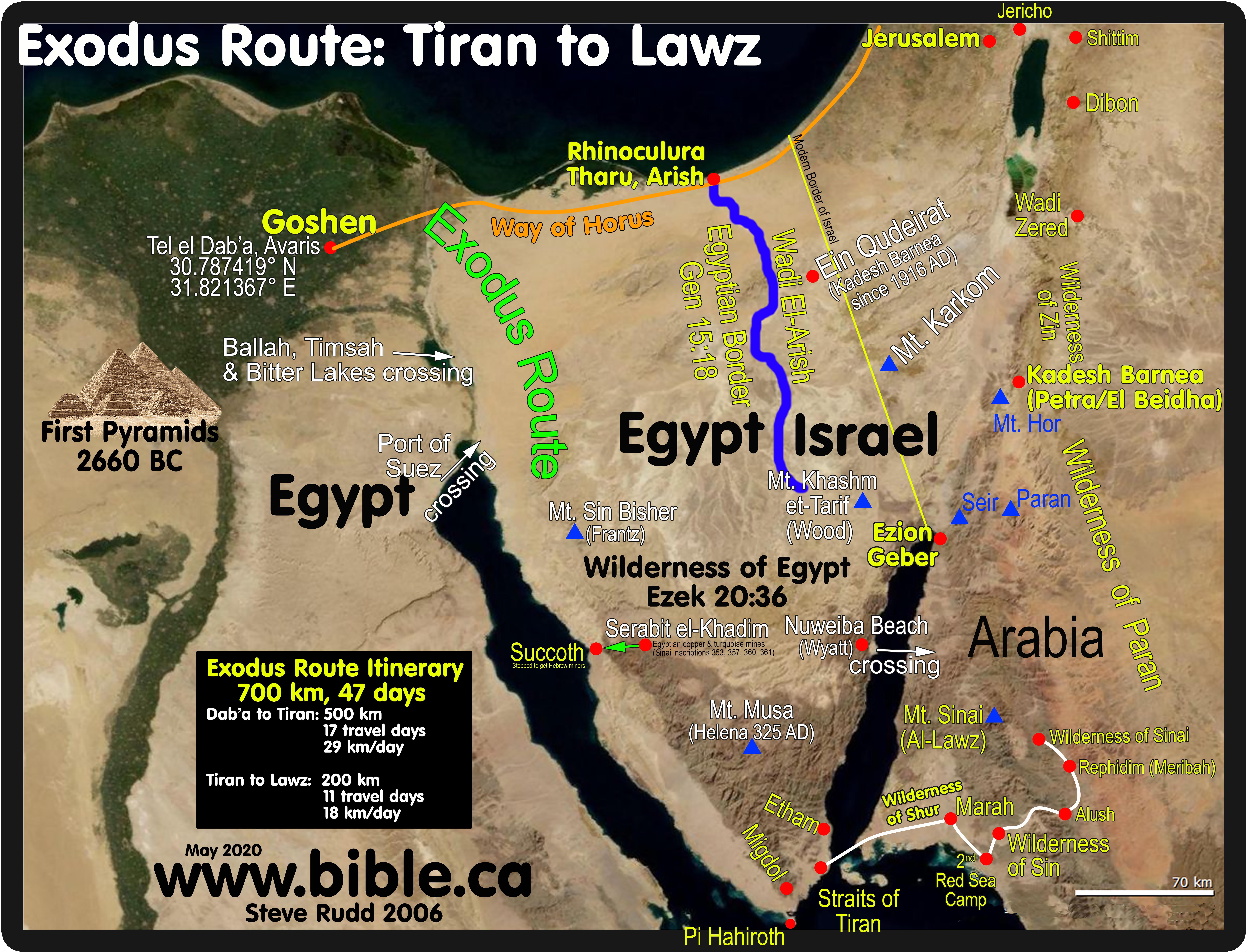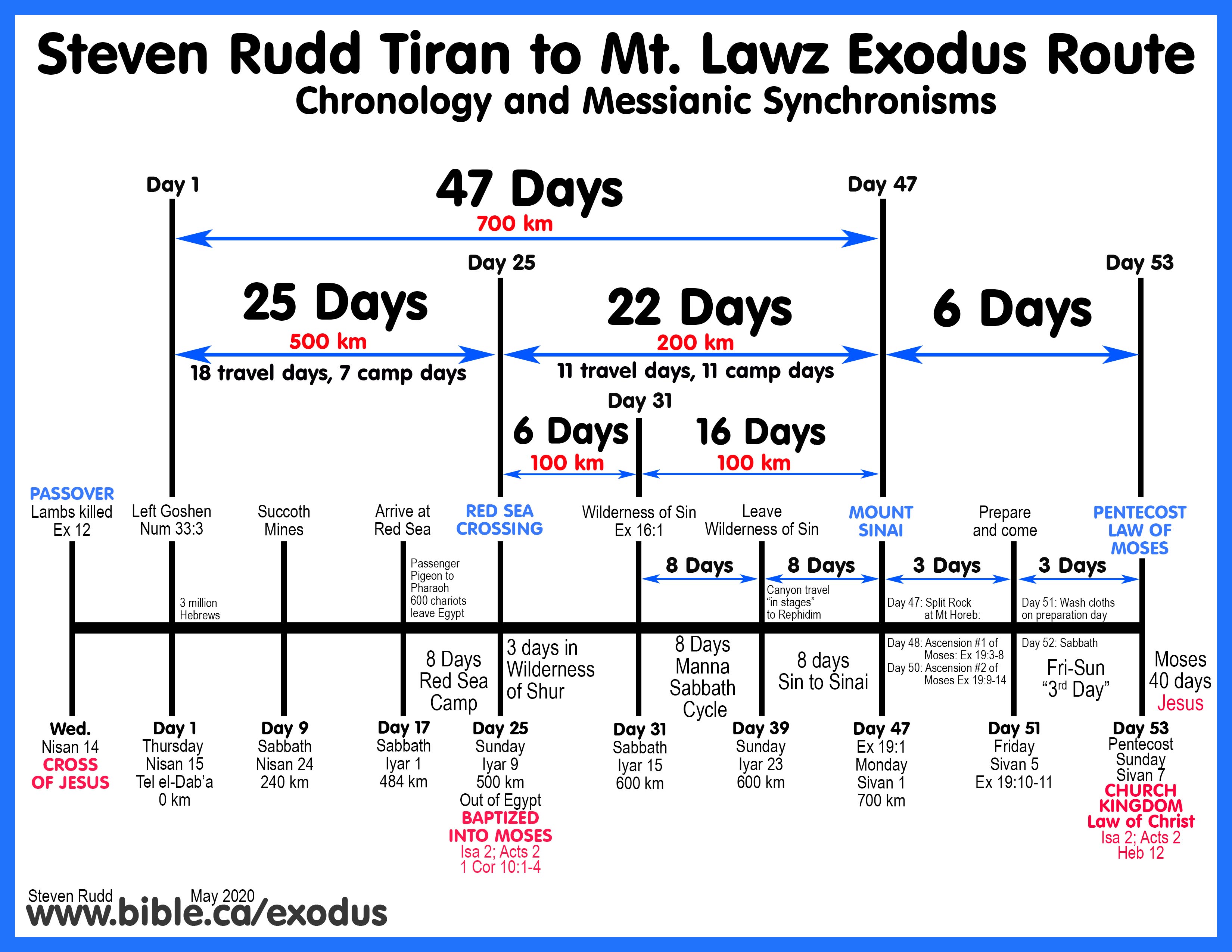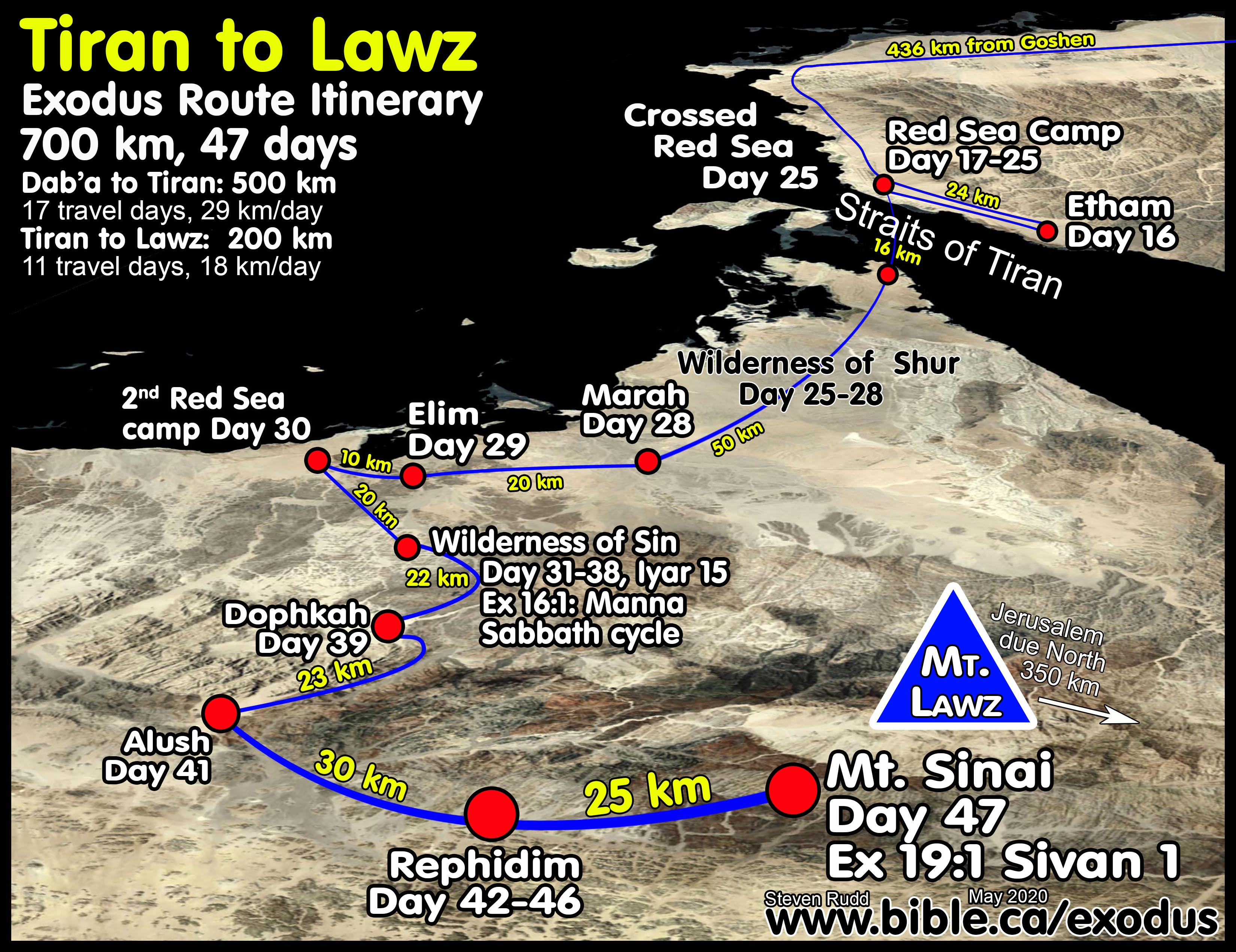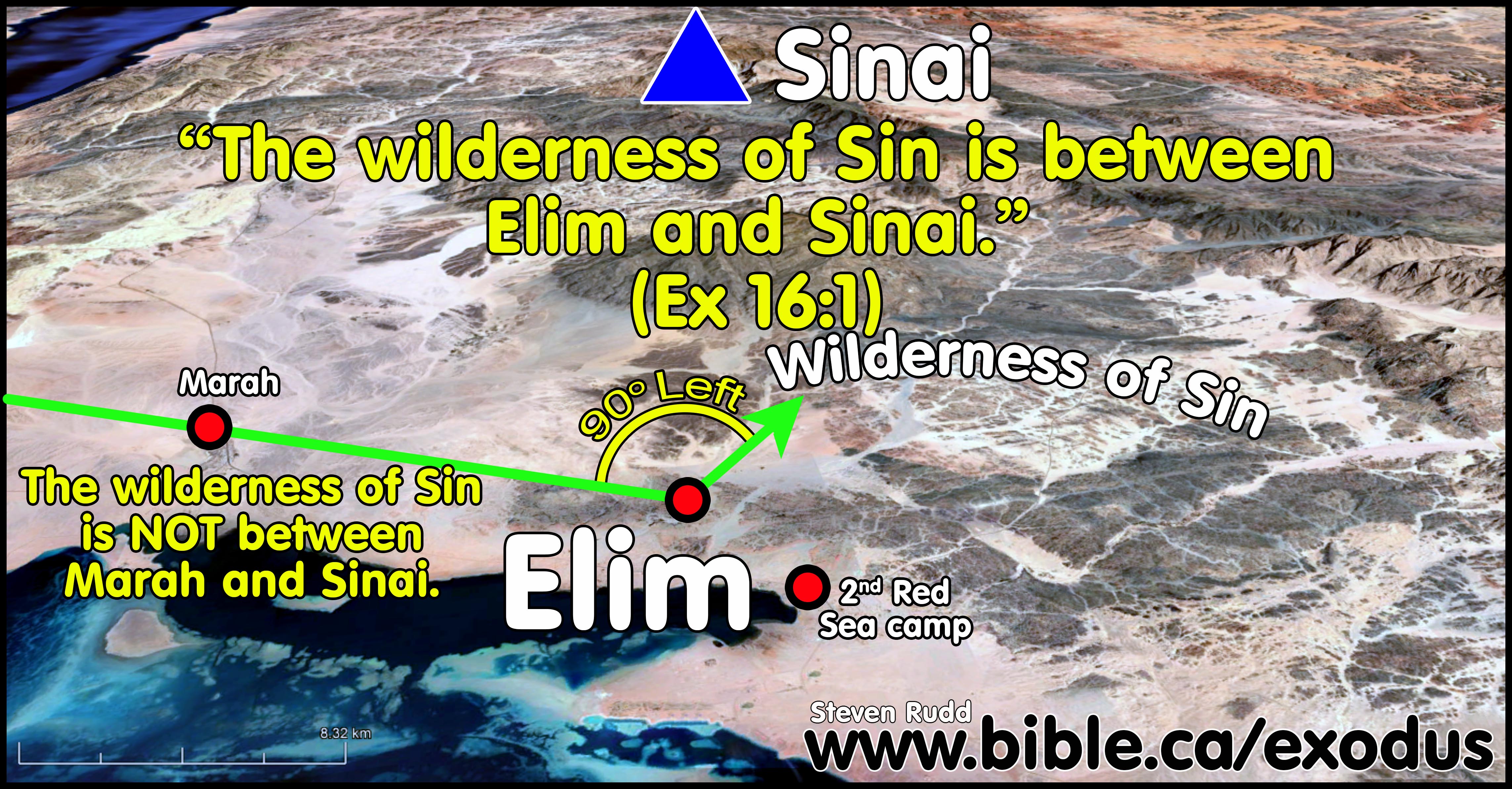The Exodus Route: The Second Red Sea Camp: Num 33:10-11
|
The 2nd Red Sea Camp (located on the Arabian Gulf) |
|
Exodus locations:
|
Introduction:
1. 5 days after crossing the Red Sea at the Straits of Tiran, Israel arrived at the second Red Sea camp on the Arabian Gulf.
a. The 1st Red Sea camp was at the Straits of Tiran
b. The 2nd Red Sea camp was located on the Arabian Gulf.
2. Any proposed exodus route that ignores the second Red Sea camp is poorly researched, superficial, and unbiblical.
a. After they crossed the Red Sea Israel went three days into the wilderness away from the Red Sea to Marah. Upon reaching Marah they headed south-east, towards the Red Sea and after camping at Elim, they reached the Red Sea.
b. We call this the second Red Sea camp, because is it the second one mentioned in scripture after the Straits of Tiran.
3. Three common errors in Exodus route maps regarding the second Red Sea Camp:
a. Most completely ignore the second Red Sea camp as though it did not exist in the Bible. These, in blissful ignorance, just draw a route on a map that never features a second Red Sea Camp then put it on the internet to mislead others.
b. Some comically engage etymological gymnastics by defining YAM SUPH as a freshwater lake with reeds, to justify their Red Sea crossing at freshwater lakes like Bitter, El-Ballah or Timsah (Sea of Reeds). After vociferously misdefining YAM SUPH as a freshwater lake of reeds, they then quietly place the second Red Sea (YAM SUPH) camp on the Saltwater Gulf of Suez hoping nobody notices the bizarre cognitive dissonance.
c. Those who propose a Red Sea crossing at Nuweiba fall into two categories in regard to the 2nd Red Sea Camp. First, there are those who take the northern route around Mt. Lawz but completely ignore the second Red Sea camp as though Num 33:10 was not in the Bible. Second, the southern route of Glen Fritz bravely proposes a second Red Sea camp west of Al Bad at Maqnah, then he quietly marks a third unbiblical Red Sea camp after the Wilderness of Sin but before Dophkah. His location for his 3rd Red Sea camp is at the identical location as Tiran crossing’s 2nd Red Sea camp. While the northern Nuweiba folk totally ignore the 2nd Red Sea camp, Fritz makes up for their omission by having TWO Red Sea camps after crossing the Red Sea at Nuweiba.
4. Bible text: "They journeyed from Elim and camped by the Red Sea. They journeyed from the Red Sea and camped in the wilderness of Sin." (Numbers 33:10–11)
A. The Second Red Sea Camp:
1. Elim must be close enough to the second Red Sea Camp that they are connected in some way, yet, remain distinct stops.
a. In the Ex 16 narrative Moses routes directly from Elim to the Wilderness of Sin and skips the second Red Sea Camp. Moses included the second Red Sea camp in his detailed Num 33 itinerary, where the order is Elim, Second Red Sea camp, Wilderness of Sin.
b. The solution is simple. There is a direct easterly line of sight between Marah, Elim and the second Red Sea camp, but the Wilderness of sin was north of both Elim and the second Red Sea camp.
c. Walking southeast from Marah, Israel camped at Elim, then continued in the same southeast direction for 10 km to reach the second Red Sea camp. Leaving the Second Red Sea camp for the Wilderness of Sin, Israel travelled north, passing Elim closely on the left side. The compass bearing upon entering Elim (From Marah) was the same compass bearing from Elim to the Red Sea as one strait line.
d. In this way, the entire congregation left Elim, visited the Red Sea which was close to Elim, then passed Elim by on route north to the Wilderness of Sin.
e. Elim at the desert oasis of Ain Ouna is a perfect fit for the Tiran crossing and a fail for the Nuweiba crossing.
2. The Nuweiba route of Glen Fritz camps twice at Elim and features an unbiblical third Red Sea camp:
|
Nuweiba Crossing Failure: Second & Third Red Sea Camps Numbers 33:10 |
|||
|
TIRAN CROSSING |
NUWEIBA CROSSING |
||
|
Scripture: Tiran |
Glen Fritz southern route |
Alternate Northern Route |
|
|
Whole Group |
Main group |
Second group |
Whole Group |
|
Elim (Ain Ouna) |
Elim |
Elim |
Elim |
|
Second Red Sea camp (Num 33:10) |
***Missing*** |
Second Red Sea Camp |
***Missing*** |
|
Wilderness of Sin |
Wilderness of Sin |
Elim |
Wilderness of Sin |
|
Dophkah |
Third Red Sea Camp |
Wilderness of Sin |
|
|
Dophkah |
Third Red Sea Camp |
||
|
Dophkah |
|||
|
PERFECT FIT |
FAIL |
FAIL |
FAIL |
a. Fritz knows his southern route to Mt. Sinai after crossing at Nuweiba is deeply flawed because it provided no logical opportunity or solution for a second red sea camp as scripture says. The same failure is true for those who cross at Nuweiba then take the northern route to Mt. Law. Fritz knows from Numbers 33:10 that there must be second Red Sea camp between the Nuweiba crossing and one stop before the wilderness of Sin. So he is forced to fabricate a fictional itinerary where the larger group went directly from Elim to the Wilderness of sin but a smaller group went from Elim to the second Red Sea camp, then back to Elim, then the Wilderness of Sin, then off to an unbiblical third Red Sea Camp. In Fritz’s fiction, neither group follow the inspired itinerary recorded by Moses of Elim, second Red Sea camp then the Wilderness of Sin. In Reality, there were three groups in the Fritz fiction: After camping at Elim (Al Bad) one group heads for the Wilderness of Sin, a second group heads for the Red Sea at Maqnah and a third group camps an additional two days waiting for those who went to the Red Sea to return.
b. Fritz’s route contradicts the Bible by rearranging the sequence of stops so that Elim is visited twice: Marah, Elim, 2nd Red Sea camp, Elim, Wilderness of Sin, unbiblical third Red Sea Camp. Fritz is to be praised that he the is the only proponent of the Nuweiba crossing that even tries to have a second Red Sea camp after crossing at Nuweiba. The Fritz route takes Israel from Elim at El Bad, west to the Gulf of Aqaba, then “backtracks” to Elim, then south to the Wilderness of Sin. Strange that Fritz has no backtrack at Etham where scripture requires it, but then adds a backtrack at the second Red Sea camp which contradicts scripture. Fritz’s backtrack adds on additional two days to his itinerary which he desperately needs to reach Mt. Sinai in 47 days as per Ex 19:1.
c. In Fritz’s fictions and fabrications, none of his groups follow the inspired itinerary recorded by Moses from Elim to the second Red Sea camp to the Wilderness of Sin and finally to Dophkah.
d. The Tiran route marks the second Red Sea camp after Elim according to the Bible, at the identical location the Fritz-Nuweiba route marks an unbiblical third Red Sea camp after the Wilderness of Sin and before Dophkah.
3. Fritz rationalizes the otherwise absurd two day journey from Elim (Al Bad) to the Gulf of Aqab (Maqnah) by suggesting the Hebrews were motivated to collect the debris from the Egyptian army after they drowned in the sea the week before. He is also forced to define Elim like a large wilderness area as opposed to a single location in spite of the fact the Bible said it had 7 springs and 70 date palms. Glen Fritz own words: comments in [square brackets] added:
a. “Elim was likely a large district in the Wadi al-‘Ifal area of Al-Bad’. Elim may have extended into Wadi Ḥamḍ. … Due to the immense size of the Exodus multitude, Elim should be envisioned as a
b. large, spread out district.” (Exodus Mysteries, Glen Fritz, p376, 387, 2019 AD)
c. “The continuation to Yam Suph, 30.5 km (19 mi.) from the Al-Bad’ part of Elim, is a bit of a conundrum because it amounted to a significant deviation from the net course of the journey to Mount Sinai. It was essentially a dead end destination with limited potable water and encampment space.” (Exodus Mysteries, Glen Fritz, p391, 2019 AD)
d. “A “contingency” [smaller group 2 who went from Elim, Maqnah, Elim, Wilderness of Sin] of the Hebrews continued to the shore of Yam Suph near present day Makna, 30 km (19 mi.) from Al-Bad’. A “contingency” [smaller group 2] is suspected rather than the entire multitude [larger group 1 who bypassed Maqnah and wend directly to the Wilderness of Sin from Elim], because this encampment was only listed in the Numbers 33 itinerary; it was not mentioned in the Exodus 16 itinerary. Practically speaking, the entire multitude could not easily encamp at the sea in the Makna area due to terrain and water limitations. At Yam Suph, the Hebrews happened upon the wreckage of the Egyptian army strewn along the coast, which had drifted 64 km (40 mi.) south from the site of the sea crossing debacle a week earlier. This providential circumstance allowed them to salvage weapons and other useful objects transported from Egypt for them by thousands of troops and hundreds of chariots. The multitude moved south from the Yam Suph and Elim encampments into the adjacent Wilderness of Sin, arriving about 10 days after the sea crossing exit and one month after leaving Egypt (Exo. 16:1).” (Exodus Mysteries, Glen Fritz, p469, 2019 AD)
e. “However, the initial arrival of the multitude in the Wilderness of Sin likely preceded the hundreds of thousands trailing behind by several days.” (Exodus Mysteries, Glen Fritz, p399, 2019 AD)
B. Timing and distances:
![]() Travel
times, distances, days of the week
Travel
times, distances, days of the week
- They arrived at the Red Sea camp on Friday, day 30 from Goshen and day 5 from the Red Sea crossing.
- At this point, they have traveled a total of 80 km in 5 days, which gives us an average daily travel rate of 16 km per day between the Red Sea crossing point at Tiran and the second Red Sea camp on the Arabian Gulf.
C. Photos and maps:
Here is an overview map with all the locations between the Red Sea crossing and Mt. Sinai with distances and times.
|
The beach where they camped on day 5, which was 10 km from Elim |
|
|
Route from Marah to Alush |
|
|
First Red Sea camp to the Second Red Sea camp, then the Wilderness of Sin. |
|
|
The 2nd Red Sea camp was located near Elim where scripture indicates they turned towards Mt. Sinai for the first time since crossing the Red Sea. |
|
|
Marah to the Wilderness of Sin |
D. How the traditional choice for 2nd Red Sea camp fails:
- The Bible says after crossing the Red Sea, Israel traveled 3 days in the Wilderness of Shur and came to Marah, then Elim, then camped beside the Red Sea a second time. This means that Marah and Elim were not beside the Red Sea but somewhere inland. The traditional location on most Bible maps for the Marah and Elim are on the east coastal plain of the Red Sea. The coastal flat is only about 10 km wide at this point.
- Because traditional route has Israel traveling down the east side of the Gulf of Suez in a narrow coastal plain, all three locations (Marah, Elim, second Red sea camp) are by the Red Sea. This makes no sense because Marah and Elim should not be near the Red Sea or else the narrative saying they left Elim and camped by the Red Sea is nonsense. If this was the case it would say they left the Red Sea and camped again by the Red sea at Marah, and left Marah and camped by the Red Sea again at Elim, then left Elim and camped by the Red Sea.
- Red Sea NOT Sea of Reeds. Those who say the Red Sea crossing was at the freshwater lakes of Ballah Lake, Timsah Lake or the Bitter lakes always insist that "Red Sea" = "freshwater sea of reeds".
- They always go into a long study of the Hebrew original or Egyptian hieroglyphics. But Red Sea is never used of a freshwater lake and we can be certain that Ezion-geber was on the SALTY Red Sea near Elat in the Territory of Edom: "King Solomon also built a fleet of ships in Ezion-geber, which is near Eloth on the shore of the Red Sea, in the land of Edom." (1 Kings 9:26)
- When these “sea of reeds” advocates are pressed for a location of a second Red Sea camp, they will then chose the SALTY Gulf of Suez. Did you catch that? After arguing vociferously that Red Sea means "sea of reeds" saying, "ITS IN THE HEBREW and must be a freshwater lake" they place the second Red sea camp on the Gulf of Suez. How hopeless for truth's sake!
- This location is the second time they camped by the Red Sea after crossing, not the third as Glen Fritz suggests.
By Steve Rudd: Contact the author for comments, input or corrections.










